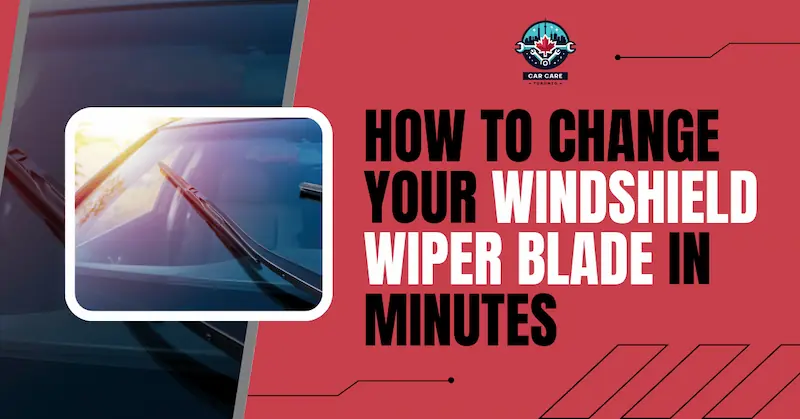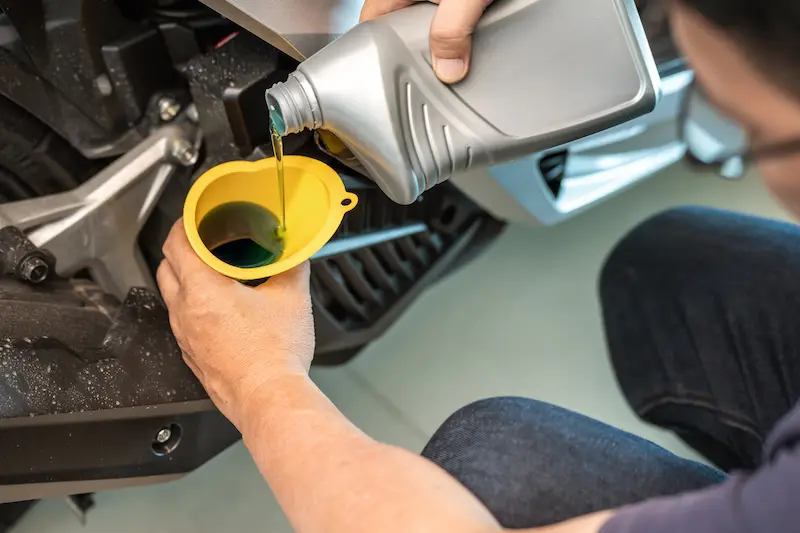Keeping your windshield clear is essential for safe driving, and a good set of wiper blades makes all the difference. But when those blades start squeaking, streaking, or skipping, it’s time for a replacement. Fortunately, changing your windshield wiper blade is quick and easy. With a few tools and some simple steps, you’ll have your wipers working like new in no time.
In this guide, we’ll cover everything you need to know about replacing your windshield wiper blade. From the tools you’ll need for the job to handling tricky attachments, we’ll walk you through the entire process. Plus, we’ll help you recognize the signs that it’s time for new blades, so you’re always prepared for rainy days ahead.
Tools You’ll Need for a Quick Swap
Changing your windshield wiper blade is one of the easiest car maintenance tasks you can do yourself. The right tools and a few minutes of your time are all it takes to ensure your wipers perform perfectly when it counts. Here’s a list of everything you’ll need for a smooth and successful blade swap.
New Windshield Wiper Blades
Before anything else, make sure you have the correct replacement blades for your car. Wiper blades come in different sizes, and using the wrong size could leave parts of your windshield unwiped or lead to improper fitting. Check your car’s manual or look up the correct size at your local auto store. Most stores even have size guides right in the aisle, making it easy to grab the right pair.
Having the right windshield wiper blade is like having the perfect tool for the job. It ensures clear visibility and smooth operation, so don’t skip this step!
A Clean Rag or Paper Towels
When you remove the old wiper blade, you’ll want to clean the wiper arm before installing the new one. Dirt, grime, or leftover residue can cause issues with the fit or reduce the blade’s lifespan. A clean rag or some paper towels are perfect for wiping down the arm and ensuring everything is neat and ready for the new blade.
Cleaning the wiper arm is quick, and it gives your new windshield wiper blade the best chance at long-lasting performance. Plus, a clean surface always looks better!
A Screwdriver (Optional)
Most windshield wipers snap into place, but some designs might include a small screw to secure the blade. If your wiper arm has a screw, you’ll need a flathead or Phillips-head screwdriver to remove and reattach it. It’s a good idea to have one handy, just in case.
While it’s unlikely you’ll need this tool, it’s better to be prepared than to stop mid-swap to search for one. A screwdriver is a small item that can save you a lot of frustration.
Glass Cleaner for Better Visibility
Before you finish installing the new windshield wiper blade, take a moment to clean your windshield. A streak-free glass cleaner works wonders for removing dirt, smudges, and bugs. Cleaning your windshield ensures the new wipers glide smoothly across the surface, giving you crystal-clear visibility in rain, snow, or road spray.
This extra step may feel minor, but you’ll thank yourself the next time you need to rely on your wipers. Plus, who doesn’t love a spotless windshield?
Gloves for a Clean Swap
Gloves aren’t required, but they can make the process more comfortable. Worn-out wiper blades can leave grease or grime on your hands, and gloves can save you from dealing with the mess. If you’re working in colder weather, gloves also keep your hands warm and steady while you swap out the blades.
Think of gloves as an optional bonus—they’re not a must-have, but they definitely make the job easier and cleaner.
A Few Minutes of Patience
Finally, set aside five to ten minutes of your time for the entire process. Rushing through can lead to improper installation, which could cause the new blade to fall off or work incorrectly. Taking your time ensures everything is aligned, secure, and ready to go.
Swapping a windshield wiper blade doesn’t take long, and the small effort pays off big time when the rain starts pouring.
Why Preparation Matters
Having the right tools ready makes swapping a windshield wiper blade simple and stress-free. With new blades, a clean windshield, and a little patience, you’ll complete the job quickly and get back on the road. A clear windshield isn’t just convenient—it’s essential for safe driving. So, gather your tools and give your car the upgrade it deserves.
Step-by-Step Guide for Standard Wiper Blade Replacement
Replacing your windshield wiper blade might seem tricky, but it’s easier than you think. With a few simple steps, you’ll have new blades ready to tackle any weather. Let’s walk through the process step by step so you can get the job done in minutes.
Step 1: Lift the Wiper Arm
Start by lifting the wiper arm away from the windshield. The arm should stand upright, allowing you to access the blade easily. Be careful not to let the arm snap back—it’s spring-loaded and could crack your windshield. Use one hand to hold the arm steady while you work.
This step ensures you have a clear view of the windshield wiper blade and its attachment mechanism. If the arm feels stiff, a little wiggle should help it lift smoothly.
Step 2: Locate the Release Tab
Inspect where the blade connects to the wiper arm. Most blades use a hook-style or pin-and-clip attachment. Look for a small release tab—usually on the underside of the blade. Press or slide this tab to unlock the blade from the arm.
This is where the magic happens. Once you press the tab, the old blade should slide off easily. If it’s stuck, a gentle tug will do the trick.
Step 3: Remove the Old Blade
With the release tab pressed, slide the old windshield wiper blade off the arm. Pay attention to how the blade was attached so you can install the new one correctly. Take a moment to check for dirt or corrosion on the wiper arm, and clean it with a cloth if needed.
This quick cleaning step helps the new blade fit snugly and prevents unnecessary wear on the wiper arm. A clean arm ensures smooth operation.
Step 4: Attach the New Blade
Take the new windshield wiper blade and align it with the wiper arm. Slide it into place until you hear a click or feel it lock securely. Double-check that the blade is properly seated—loose blades can fall off during use.
The clicking sound is your confirmation that the new blade is secure. Give the blade a gentle pull to make sure it’s locked in tightly.
Step 5: Lower the Wiper Arm Carefully
Once the new blade is attached, lower the wiper arm gently back onto the windshield. Don’t let it snap down—this could damage the glass or the new blade. Use both hands if needed to control the arm’s movement.
Your windshield wiper blade replacement is almost done, and it’s looking good already!
Step 6: Test the Wipers
Hop into your car and turn on the wipers to test their movement. Spray some washer fluid to see how the new blades perform. If they move smoothly and leave a streak-free finish, you’ve nailed it. If something feels off, double-check the attachment.
Testing ensures your new blades are properly installed and ready for action. This quick check gives you peace of mind during your next rainy drive.
Related Articles
- Best Oil for Winter Driving in Ontario: What You Need to KnowWinter in Ontario can be brutal, with temperatures often dropping well below freezing. For drivers, this means not only battling icy roads but also ensuring that their vehicles are equipped
- Car Repair in Ontario: Why Car Care Toronto is Your Best ChoiceWhy Reliable Car Repair in Ontario is Essential Driving in Ontario means facing a range of conditions, from icy winter roads to the daily wear and tear of city driving.
Tips for Tricky Attachments and Unique Wiper Designs
Not all wiper blades are created equal, and some can feel like puzzles waiting to be solved. If you’ve ever struggled with a tricky attachment or a unique wiper design, you’re not alone. Let’s break down some simple tips to make replacing your windshield wiper blade easy, no matter the challenge.
Understanding Unique Attachment Styles
Different cars use different wiper attachment mechanisms, from hook styles to pin-and-lock designs. While the hook style is the most common, unique designs can leave you scratching your head. If your windshield wiper blade doesn’t slide off easily, take a moment to inspect the attachment point. Look for release tabs, small clips, or screws holding the blade in place.
Some luxury cars or newer models might even have proprietary wiper systems. If you’re unsure, your car’s manual or a quick search online can clarify how the attachment works. Knowing the design helps you approach the replacement with confidence.
Using the Right Tools for Tough Attachments
Sometimes, a tricky windshield wiper blade needs a little extra help to come loose. A flathead screwdriver can be a lifesaver for stubborn clips or tabs. Use it gently to press the release mechanism without damaging the blade or wiper arm.
For screw-secured blades, grab a Phillips-head screwdriver. These small tools are easy to keep in your glove compartment and can save you a trip back inside the house. Having the right tool on hand makes any tricky attachment feel manageable.
What to Do with Spring-Loaded Arms
Spring-loaded wiper arms can be intimidating, especially when you’re worried about them snapping back onto your windshield. To avoid a cracked windshield, place a soft cloth or towel on the glass while you work. This simple precaution protects your car and gives you peace of mind while swapping the windshield wiper blade.
If the arm resists lifting, give it a gentle wiggle. Most spring-loaded designs are built to stay in position during replacements, but it’s always good to handle them carefully.
Tackling Specialty Wiper Designs
Beam blades and hybrid wipers are modern alternatives to traditional designs, offering improved performance and durability. However, they often come with unique installation processes. Beam blades might have integrated connectors, while hybrid blades could feature additional clips or hinges.
When working with these designs, take your time. Many manufacturers include a small instruction manual or diagram with the new blade. Following these steps ensures a smooth installation and prevents damage to your windshield wiper blade or arm.
When in Doubt, Ask for Help
If you’re feeling stuck or unsure, don’t hesitate to ask for help. Auto parts stores often offer free installation services when you purchase a wiper blade. The staff can show you how to remove the old blade and attach the new one, making it easier to do it yourself next time.
Online video tutorials are another great resource. Watching someone handle the same tricky attachment can provide clarity and boost your confidence.
Test Your Work Before You Drive
Once you’ve tackled the attachment and installed your new windshield wiper blade, it’s time to test it out. Hop into your car, turn on the wipers, and spray some washer fluid. Check for smooth motion and clear wiping across the windshield. If everything looks good, you’re all set!
Testing ensures that you’ve secured the blade correctly and prevents surprises during your next rainy drive. If something feels off, revisit the attachment point to make adjustments.
Make Tricky Attachments a Breeze
Replacing a windshield wiper blade doesn’t have to feel like solving a riddle. With the right tools, a little patience, and these tips, even the trickiest attachments and unique designs become manageable. Take your time, follow the steps, and enjoy the satisfaction of a job well done. Clear windshields are just a quick swap away!
When to Know It’s Time for New Windshield Wiper Blades
Windshield wiper blades don’t last forever, and knowing when to replace them is key to safe, clear visibility. If you’re wondering whether it’s time to swap out those worn-out blades, here’s how to recognize the signs and keep your windshield crystal clear.
Streaks on Your Windshield
The easiest way to tell it’s time for a new windshield wiper blade is if your wipers leave streaks behind. Worn-out blades lose their ability to press evenly against the glass, creating annoying streaks that block your view. If you notice this happening—even after cleaning your windshield—it’s time for a replacement.
Streaks are more than just annoying; they’re a safety hazard. Replacing your wiper blades promptly ensures you can see clearly during rain or snow.
Squeaking or Chattering Sounds
Your windshield wiper blade should glide smoothly across the glass. If you hear squeaking, chattering, or skipping noises, it’s a sign the rubber is wearing out. Over time, the edges of the blade harden or crack, reducing their flexibility and causing that annoying sound.
When your wipers sound like they’re arguing with the windshield, grab a fresh pair of blades. It’s an easy fix that makes driving more enjoyable and quieter.
Visible Wear and Tear
Take a moment to inspect your windshield wiper blade. Look for cracks, tears, or bent frames. Damaged rubber or a deformed blade won’t provide effective wiping, leaving you with patches of water or dirt on the glass.
Regularly checking your blades for wear and tear helps you catch issues before they become a bigger problem. A quick visual inspection can save you from dealing with poor visibility during bad weather.
Reduced Performance During Heavy Rain
If your wiper blades struggle to clear water during heavy rain, they’re past their prime. Wipers are designed to handle intense conditions, but older blades lose their effectiveness over time. This can lead to poor visibility when you need it most.
Swapping out your windshield wiper blade before the rainy season ensures you’re prepared for whatever the weather throws at you.
Seasonal Changes
Extreme temperatures can take a toll on your windshield wiper blade. Cold winters can cause the rubber to harden, while hot summers can make it crack. Many drivers replace their blades twice a year—once before winter and once before summer—for optimal performance.
If you live in an area with extreme weather, consider this seasonal routine to keep your wipers working at their best year-round.
How Often Should You Replace Your Blades?
Most experts recommend replacing your windshield wiper blade every 6 to 12 months, depending on usage and weather conditions. If you notice any of the signs mentioned earlier, don’t wait—swap them out as needed.
Regular maintenance helps you avoid the frustration of streaky windows and noisy wipers. Plus, it’s an easy way to improve your driving experience.
Keep Your Windshield Clear and Safe
Knowing when to replace your windshield wiper blade ensures clear visibility and safer driving. From streaks and squeaks to visible damage, these signs are your wipers’ way of telling you they need a break. Stay proactive, and enjoy the peace of mind that comes with a perfectly clear windshield.
Keeping Your Wipers in Top Shape: Final Tips and Options
Changing your windshield wiper blade is easier than it seems when you have the right tools and a clear guide. From gathering essentials like new blades and a screwdriver to following simple steps, you can replace your wipers in minutes. Tricky attachments or unique designs might feel challenging at first, but with the tips shared here, you’ll be prepared for any setup.
Knowing when to replace your windshield wiper blade is equally important. Signs like streaks, squeaking, or visible wear mean it’s time for a swap. Regularly inspecting your wipers ensures clear visibility, which is crucial for safe driving. And remember, extreme weather can affect blade performance, so don’t wait for a downpour to find out they need replacing.
If you’re still unsure or prefer professional help, visit Car Care Toronto for expert windshield wiper blade replacement. They can also check the overall health of your car, giving you peace of mind for the road ahead. Whether you DIY or head to a professional, keeping your wipers in top shape is always worth the effort.









